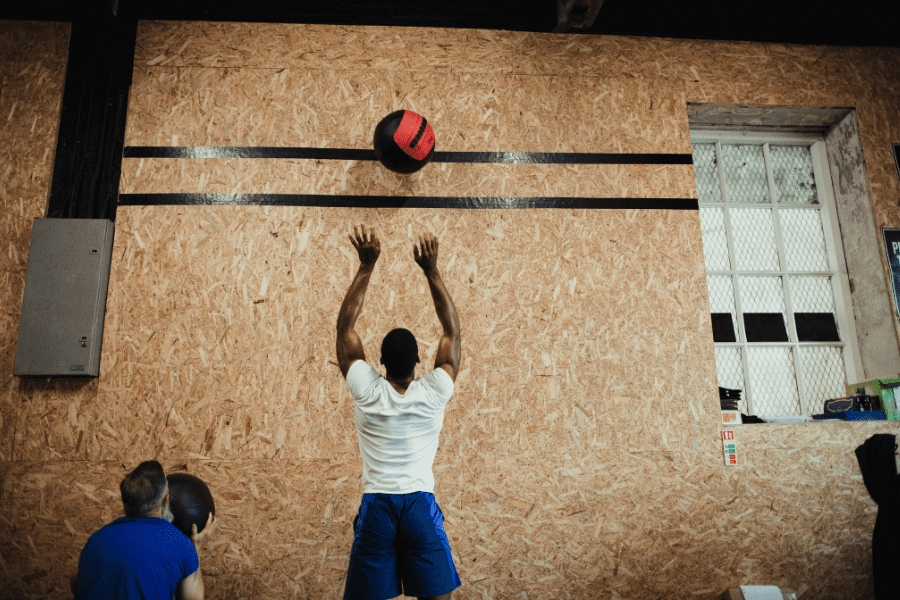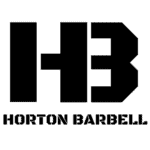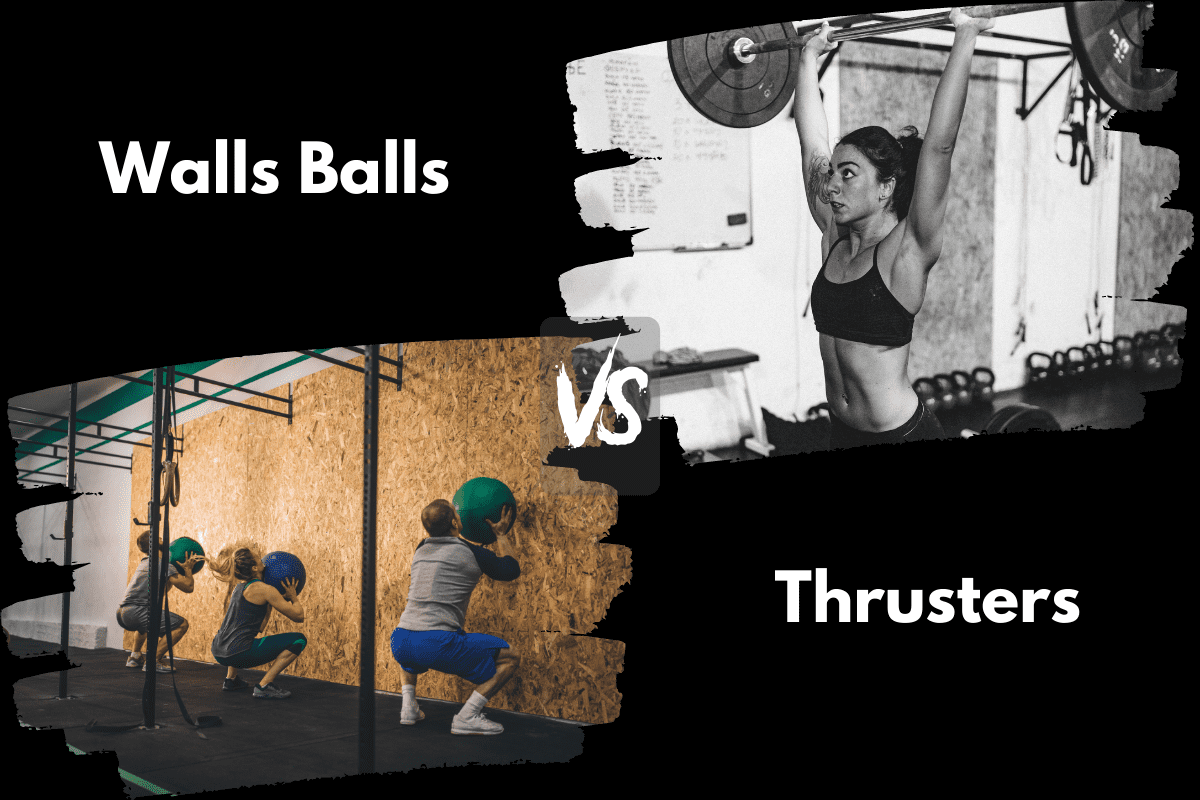Wall Balls vs Thrusters (Benefits & Differences)
Two exercises that have become extremely popular thanks in large part to CrossFit are Wall Balls and Thrusters. Both exercises are total body movements that combine a powerful hip drive with an explosive overhead press.
The question you may be asking yourself though, aside from equipment, what is the actual difference between the two? And, is one movement really better than the other?
In this guide, I’m going to do my best to answer those questions. First, I’ll showcase each exercise individually – how to do them properly, benefits, coaching tips, etc. Then, I’ll compare the two side by side to see if one is actually better than the other for some common lifting goals.
Let’s start with Wall Balls first.
Wall Balls

Equipment Needed
- Medicine Ball
- Wall at least 10 feet tall that you don’t mind hitting a medicine ball off of
Muscles Worked
- Wall Balls are a total body exercise. Almost every muscle group in the body is utilized at some point during the movement.
How To
- Start with a medicine ball held right at the chest.
- Now, with feet shoulder-width apart and core braced, descend down into a squat.
- Once you reach full depth, explosively drive up.
- As you reach full extension with the hips, throw the ball vertically to a spot 10 feet up on the wall.
- Catch the ball as it falls down from the wall and repeat.
Coaching Points
I know many CrossFit workouts prescribe a high volume of Wall Ball reps and encourage you to work as fast as possible. Having said that, always make sure that you’re able to maintain proper technique and keep a braced core when squatting.
Don’t let the combination of fatigue and trying to rush cause you to use poor technique as this can lead to injury.
Don’t have a medicine ball (or maybe a wall to throw it against)? Here are 8 Wall Ball alternatives that you may be able to do instead (Spoiler Alert: Thrusters are one of them)
Benefits of Wall Balls
Wall Balls are a compound exercise that works multiple muscle groups, including the legs, core, shoulders, and arms, providing a full-body workout.
Wall Balls are an intense exercise that requires significant physical effort, making them a great way to increase cardiovascular endurance and fit perfectly as part of a high-intensity circuit.
Wall Balls are a great movement for beginners to learn body position and technique for many barbell exercises like Front Squat and Push Press.

Tired of coming up with your own workouts? But don’t want to pay an arm and a leg?
I post workouts 5 days a week right here. (Did I mention they’re free?)
Thrusters

Equipment Needed
- Barbell
- Bumper Plates (Iron Plates are technically okay too, but you’ll need to be careful putting the bar down)
Muscles Worked
- Thrusters are a total body exercise. Almost every muscle group in the body is utilized at some point during the movement.
How To
- Start with the barbell in a front rack position – the same as you would for a Front Squat.
- To get to this position you can either take the bar out of the rack or clean it from the floor.
- Now, with feet shoulder-width apart and core braced, descend down into a Front Squat.
- Once you reach full depth, explosively drive up.
- As you reach full extension with the hips, drive the bar up to an overhead position.
- Return the bar back to the starting position on the shoulders and repeat.
Coaching Points
This is a complex movement, combining the movements of two technical lifts – the Front Squat and the Push Press. If you’re not already proficient in both of those lifts I would recommend following the links to each of those individual exercises and becoming familiar with those first.
I know many CrossFit workouts prescribe a high volume of Thruster reps and encourage you to work as fast as possible. Having said that, always make sure that you’re able to maintain proper technique and keep a braced core when squatting.
Don’t let the combination of fatigue and trying to rush cause you to use poor technique as this can lead to injury.
Need an alternative for Thrusters? Here are 8 Thruster alternatives you can try.
Benefits of Thrusters
Thrusters are a total body movement that help to build strength in the lower body, upper body, and core, which can improve overall strength and performance.
Also, because Thrusters are a total body movement, they require a significant amount of physical effort, making them a great way to increase cardiovascular endurance if done at higher reps.
Wall Balls vs Thrusters: Which is Better?
Now, let’s do a side-by-side comparison to see which is better for some common lifting goals.
Better For Developing Strength: Thrusters
Thrusters are better than Wall Balls for developing strength (and size) simply due to their ability to scale.
The heaviest medicine ball that most of us will have access to is 20 pounds. On the other hand, you can continue to add weight to Thrusters as much as your strength allows. Wall Balls with a 20-pound medicine ball is just not going to be able to develop the same type of strength as a 185-pound Thruster.
Better For Beginners: Wall Balls
Thrusters are a rather technical movement. You need to be able to do a proper Front Squat with a barbell. You need to be able to transition from a Front Squat grip on the bar to a closed grip to press the bar overhead. Then, you need to be able to rerack the bar on the shoulders correctly to continue the set.
Wall Balls are essentially the same movement pattern, but holding a medicine ball instead of a properly front-racked barbell. This makes Wall Balls much less intimidating and much easier to pick up and learn for a beginner.
I would suggest doing Wall Balls while you learn how to do some of the basic barbell movements like a Front Squat.
Are Thrusters a Good Sub for Wall Balls?
Assuming you can perform them properly, yes, Thrusters are the closest sub for Wall Balls. The movement patterns and muscles worked are practically identical.
The real question, though, tends to be how many Thrusters does one need to do to replace Wall Balls? In other words, if a workout calls for 50 Wall Balls with a 20-pound ball, how many Thrusters with a 45-pound bar does that equal?
This is a really tough question for a number of reasons.
First, I’m not a physics major. Wall Balls are lighter, but more force has to be generated to throw the medicine ball ten feet into the air. Thrusters are a heavy weight, but don’t involve throwing the bar (at least they shouldn’t be!).
Second, from an anecdotal perspective, you can ask 10 people which they believe is harder, you’ll get 10 different responses. One person may say the same, one may say Wall Balls are slightly harder and another may say Thrusters are WAY tougher.
This is just something you’re going to have to play around with to find out what feels equal to you. If you find Thrusters with a 45-pound bar much more difficult, try a 10kg plate or 15-pound dumbbells. If you find Wall Balls way harder, then try a lighter medicine ball (if subbing the other way).

Need a Training Program?
Coach Horton has 20 years of experience training elite level athletes at schools like the University of Tennessee and Georgia Tech. He has also written plenty of programs for other coaches and friends and family.
So, whether you need a program to improve your performance in your sport or you just want to look good at the beach, there is a program designed just for you.
Final Thoughts
Wall Balls and Thrusters are both total body movements that demand an explosive leg drive and a powerful overhead push.
Thrusters have the ability to scale and therefore build more strength, but Wall Balls are technically easier and a better fit for beginners.
And, finally, depending on equipment availability, each exercise can be substituted for the other as long as technique isn’t an issue. How many reps of equals the other though is something each person needs to decide for themselves.

